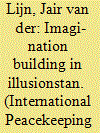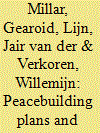| Srl | Item |
| 1 |
ID:
123993


|
|
|
|
|
| Publication |
2013.
|
| Summary/Abstract |
A variety of international actors, such as the UN and NATO, intervene in complex environments, such as Afghanistan. In order to overcome complexity and for 'us' to deal with 'them', constructs such as 'the insurgents' and 'the government' are used to help 'our' understanding and to simplify the picture. Subsequently, these constructs become subject to nation building and counterinsurgency theories applied by the 'international community'. Many of these are suboptimal because their subjects were constructs in the first place. The result is a shadow boxing match, in which international policies dissolve in local realities. On the basis of social psychology theories, this paper develops the hypothesis that in complex peacebuilding environments decision-makers structure and simplify disorder, which leads to suboptimal interventions, to which local actors respond in a process of friction. This hypothesis is tested on the case of Afghanistan.
|
|
|
|
|
|
|
|
|
|
|
|
|
|
|
|
| 2 |
ID:
123990


|
|
|
|
|
| Publication |
2013.
|
| Summary/Abstract |
What happens when global meets local? This special issue focuses on the dynamic interaction between externally conceived plans for peacebuilding intervention and local people's own approaches and strategies. The notion of 'friction' provides a perspective that acknowledges the unpredictable and unexpected nature of this interaction. The 'hybrid' outcomes of such dynamic interactions can vary in extent and success, as peacebuilding plans are rerouted and redesigned in practice. This special issue explores how, why, and to what effect internationally designed, funded, or administered peace projects interact with and/or are appropriated by local actors.
|
|
|
|
|
|
|
|
|
|
|
|
|
|
|
|